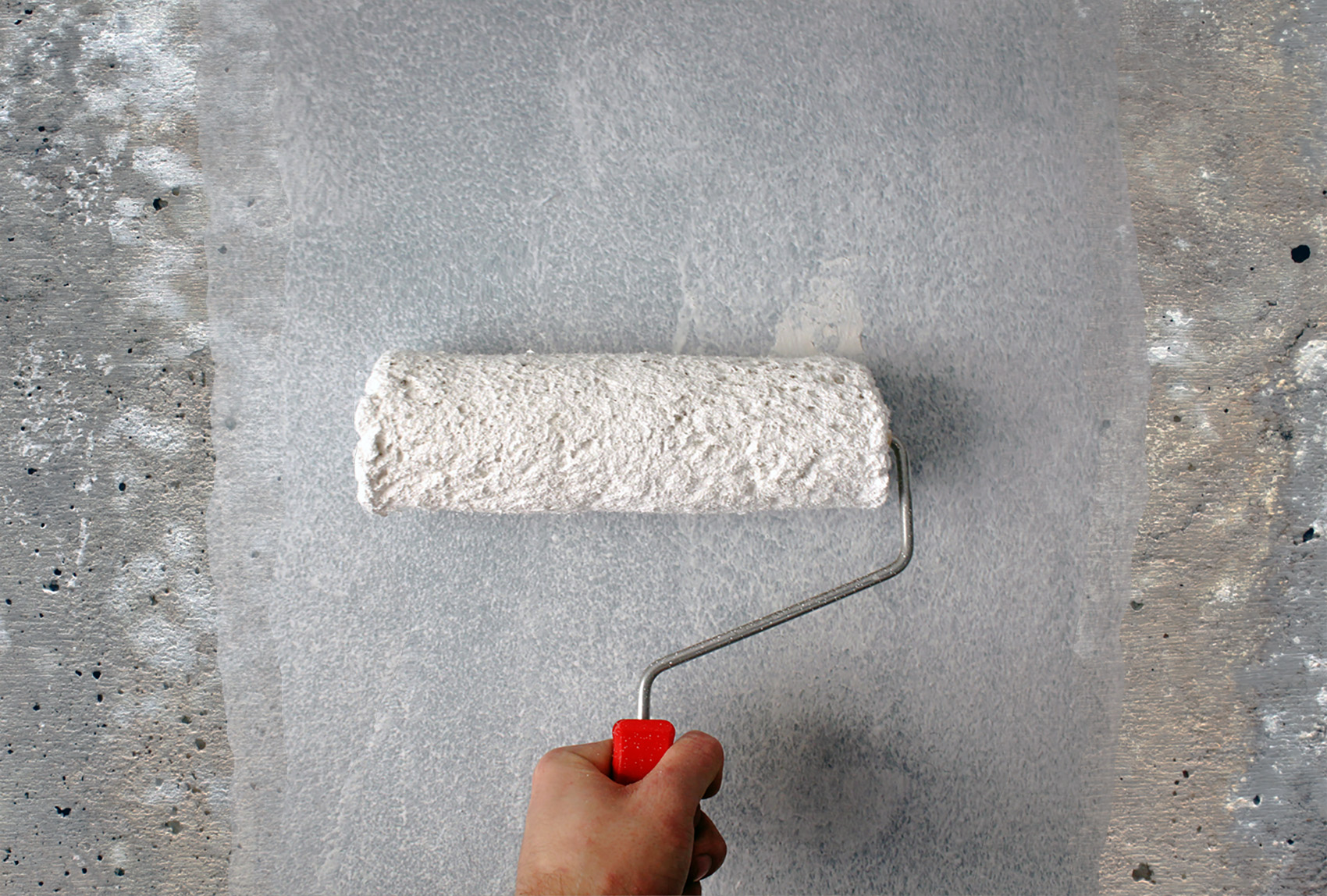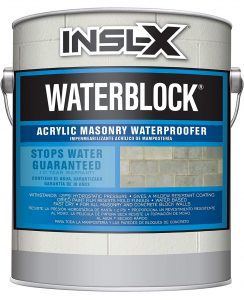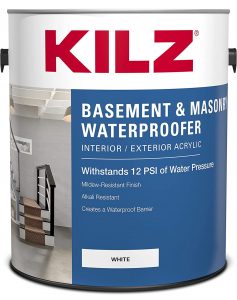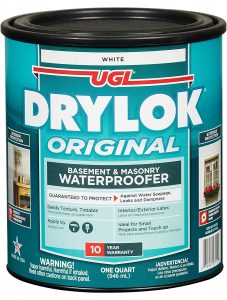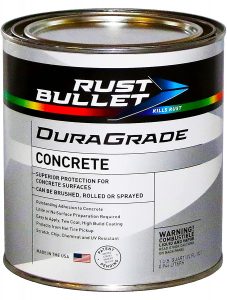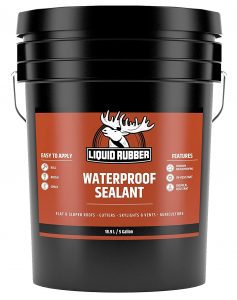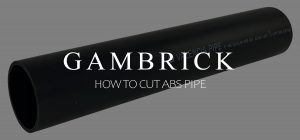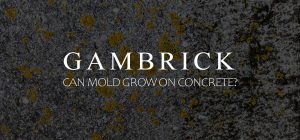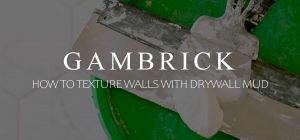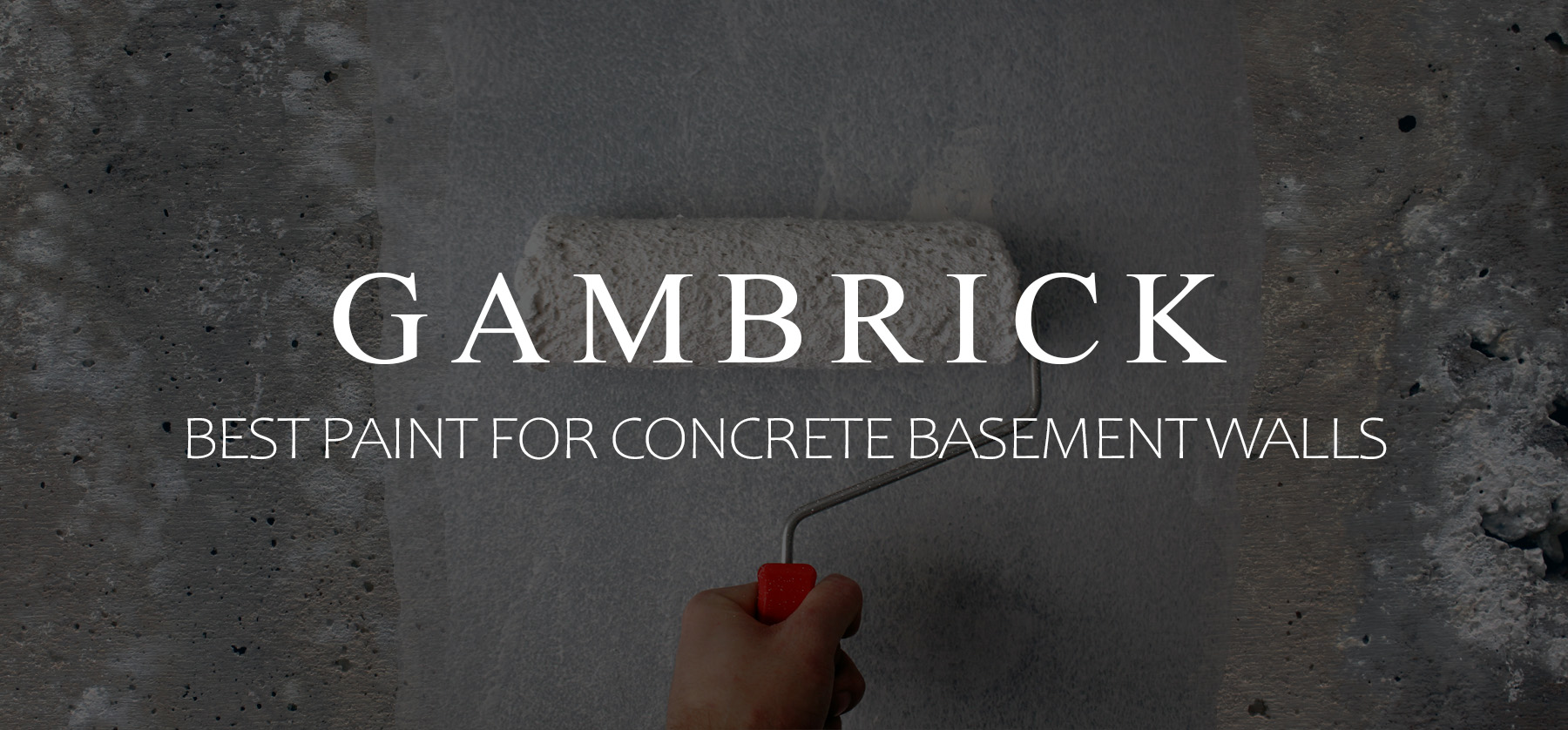
Best Paint For Concrete Basement Walls
The best paint for concrete basement walls is acrylic masonry paint. Concrete is a type of masonry that is very porous and prone to cracking as it expands and contracts. It absorbs water from the outside, which then transfers through the walls’ deep pores and into the basement. This is why many basements become damp with an odd musty smell. Concrete also expands and contracts when the temperature changes, which can cause cracking. Masonry paint is flexible, which means it can move without cracking, and it’s water resistant, which helps keep your basement dry and mold-free. Latex, epoxy, and elastomeric masonry paints are also great choices for concrete basement walls.
Another great quality of masonry paint is that it breathes. This is essential for painting basement walls because airflow helps keep the concrete dry.
Many basement walls allow moisture to seep in from the outside. This can eventually lead to mold and mildew growth from sweat forming on the walls. Because of this, you can’t use regular wall paints to coat the walls. Standard paints will peel, crack, flake, and chip off when the walls become damp. But masonry paint stays secure on the walls because it breathes.
Regular house paints aren’t designed for use in high-humidity environments. They only provide color but don’t function as a sealer. Basement walls need special waterproof paint that keeps moisture from penetrating through the walls and into the basement. As a result, mold and mildew growth, and that musty smell many basements have, can be prevented.
What Kind Of Paint Do You Use On Concrete Basement Walls
The best overall paint for concrete basement walls is acrylic masonry paint. Other great choices are masonry primers and sealers, latex, epoxy, and elastomeric paints.
- Latex paints work well on concrete but are not as waterproof as masonry paint, so I only use them when the basement is thoroughly waterproofed from the outside. They’re cheap, easy to apply, dry fast, and water-based, so they don’t smell that bad.
- Epoxy paint is a good choice for concrete basement walls because they’re waterproof and flexible. However, they’re more expensive than masonry and latex paints and take longer to dry. Epoxy doesn’t breathe well, so stick with masonry paints if your basement walls sweat.
- Elastomeric paint is super thick, it’s like liquid rubber, which makes it great for seriously rough and porous walls.
- Sealers and primers are great base coats and help prevent water penetration.
Concrete and block foundations are very porous, which means they’re permeable. Exterior water will pass right through them if they’re not sealed properly. This allows moisture to enter the basement through the walls, seen as concrete sweat.
If water reaches the exterior concrete walls, hydrostatic pressure on the walls and natural capillary action will draw it through the concrete’s pores and into the basement. This is why many basements get damp, musty, and moldy.
When a basement is finished, moisture can build between the drywall and concrete. This creates the perfect environment for mold to grow, which can then spread throughout the home.
Waterproofing paint, however, prevents this by stopping structural damage and preventing mold growth, which minimizes health risks.
The Best Paint To Use On Concrete Basement Walls
Here’s a list of the best paint to use on concrete basement walls along with when to use them.
- Best Overall: INSL-X WaterBlock Acrylic Masonry Waterproofing Paint is the overall best paint for concrete and block basement walls is acrylic masonry. It’s water-based, which makes it easy to apply without a bad odor, versatile, durable, fast drying, waterproof, and can withstand 12 PSI of hydrostatic pressure.
- Best Primer: Kilz Klear Primer Interior/Exterior is the best primer for concrete basement walls. It’s Alkali-resistant clear primer and sealer that helps protect topcoats from “hot” alkali found in concrete walls and can be applied to fresh concrete with a pH less than 13.
- Best Sealer: KILZ Basement & Masonry Waterproofer Paint is the best concrete sealer for basement walls. It’s designed to waterproof porous concrete and block walls using nanotechnology to form a barrier that helps stop water infiltration.
- Best Latex Paint: Drylok 27512 Latex Waterproofing Paint is the best latex paint for concrete basement walls. If you want a paint that’s most like regular interior house paint, this is the best choice.
- Best Epoxy: Rust Bullet DuraGrade is the best epoxy paint for concrete and block basement walls. Epoxy is the most durable paint you can use. It contains a resin and a hardener that cures to form a super hard finish.
- Best Elastomeric Paint: Liquid Rubber Concrete Waterproof Sealant is the best paint for extremely rough and porous concrete. It’s super thick like painting on liquid rubber, which is ideal for sealing rough surfaces.
Below is an in-depth description of each paint along with tips on when and how to use them.
1. Acrylic Masonry Paint
Acrylic paints are chemical based, which gives them great elasticity, color, and adhesion. This means they can expand and contract with the concrete walls and won’t flake, chip, or crack. They’re also water-resistant and breathable, which is a great combination for masonry walls because it helps keep them dry.
Acrylic paint is versatile, you can paint it on any surface that’s oil and wax free, which includes concrete. It dries quickly, which allows you to finish painting your walls faster, and it’s less toxic than most other paints which makes it safer around children and pets.
I like acrylic paint because it’s very easy to use, breathable, doesn’t require premixing, and is self-priming, so you don’t have to prime the walls before using it. The color retention is great, and you get 350 sq. ft. of coverage per gallon, which is a great value.
The best acrylic paint you can use for your basement walls is INSL-X WaterBlock Acrylic Masonry Waterproofing Paint
- Water Based
- Dries very fast
- Can be used on solid concrete or cinder block
- Waterproofing paint keeps basement walls dry
- Withstands up to 12 lbs of hydrostatic pressure (PSI)
- No premixing required
INSL-X Waterproof paint works great for solid concrete or cinder block basement walls. It dries really fast, goes on easily, and doesn’t require premixing. It also adheres really well so you can paint it on when the concrete is damp, but for the very best results, apply it on a dry surface.
2. Concrete Primer
A concrete primer can be painted directly onto a concrete or block basement wall before a top coat of regular paint. It’s alkali-resistant, which means it protects the top coat from the alkali found in masonry. It creates a protective surface over the concrete, which allows the top coat of paint to adhere. If you don’t apply a concrete primer before the top coat, it will generally flake and peel over time.
The best concrete primer you can use for your basement walls is Kilz Klear Primer Interior/Exterior
- Kilz Klear is an alkali-resistant clear primer and sealer that’s easy to apply with a brush, roller, or sprayer
- Helps protect topcoats from “hot” alkali found in concrete walls and can be applied to fresh concrete with a pH less than 13
- Can be used to seal porous surfaces
- Goes on clear
- Can be used with any top-coat
A concrete primer allows you to paint your concrete basement walls with any paint you want. Without a primer, you’re limited to using just masonry paints on the walls.
Whenever I want to paint concrete walls with standard paints, I use a concrete primer first. Kilz makes the best primers so that’s what I use on all my painting jobs. However, it’s a clear primer, so that means you need to use more paint to get adequate coverage. For dark colors, that’s not a big deal, but lighter colors may require an extra coat or two depending on the color of your concrete.
3. Concrete Sealer
Concrete sealer is a type of paint that protects a concrete or block wall from water, grease, and oil stains. The paint also enhances the natural beauty of concrete while making it easier to clean. Sealers are a great idea if your concrete walls sweat a lot because they resist water penetration but still breathe, which helps the concrete dry.
Sealers can be applied directly to concrete and block without a primer first. Paint them on with a brush, roller, or sprayer in 2-3 light coats. They’re durable, crack, scratch, and flake resistant, and flexible, so they can expand and contract with the concrete. Sealers are also very adhesive, so they’ll stick to bare concrete as long as it’s clean and fairly dry.
The best concrete sealer you can use for your basement walls is KILZ Basement & Masonry Waterproofer Paint
- Designed for porous concrete and block walls
- Low odor
- Formulated for waterproofing using nanotechnology to form a barrier that helps stop water infiltration.
- Alkali-resistant coating provides a long-lasting, durable finish.
- Can withstand 12 lbs of water pressure (PSI)
- An acrylic paint
KILZ Basement & Masonry paint can be used on above-grade interior and exterior basement walls. It helps prevent water from penetrating into and through concrete and block walls which helps keep a basement dry and mold-free.
4. Latex Paint
Latex paints are great for concrete and block basement walls because they’re cheap, easy to apply, dry quickly, and emit less odor than other paints. They’re water-based, so they paint on much easier than thicker epoxy or masonry paints. I suggest using eggshell or satin latex paint on concrete walls because it looks great and is easy to wash with soap and water. Semi-gloss is better for rooms that get humid, like a home gym, because the extra sheen helps resist moisture, but it can be a little shiny for most areas.
Latex paint lasts a long time, doesn’t peel, flake, crack, or chip easily, doesn’t smell as bad as masonry paint, and has a fantastic finish that’s easy to keep clean.
The best latex paint you can use for your basement walls is Drylok 27512 Latex Waterproofing Paint
- Guaranteed to stop water penetrating into your basement
- Helps protect against radon gas penetration by reducing vapor transfer
- Low-odor formula
- Breathable paint that won’t trap moisture in the masonry
- Fully transferable 10-year warranty
- Can withstand 10lbs of hydrostatic pressure (PSI)
- Can be applied with a sprayer, brush or roller
There are a few types of Drylok formulas that work really well on concrete basement walls, but formula 27512 is the best. It’s designed to withstand up to 10 lbs of hydrostatic pressure (PSI), which is equal to a wall of water 22 feet high. That amount of strength is extremely beneficial if your basement walls are prone to sweat.
Drylok paint fills and seals concrete surface pores to create a water-tight barrier that keeps your basement dry.
In addition to being waterproof, the paint comes pre-mixed, paints on easily with a brush, roller, or sprayer, is very affordable, and doesn’t smell that bad.
5. Epoxy Paint
Epoxy paints contain resin and hardeners that cure extremely tough and durable. They’re highly resistant to staining, cracking, flaking, and peeling. Most epoxy paints are used for concrete floors because of how tough they are, but you can also use them on walls if you need an extra durable finish.
Epoxy paints are harder to apply than other types of paints because they contain a resin and hardener that cures extremely hard. The result is an extremely hard and durable finish, but it’s overkill for most basement walls.
I typically use epoxy paints on a concrete floor with masonry or latex paint on basement walls. But epoxy can be a good choice for basement walls if you need an extra tough finish. For example, if you have lots of pets that scratch the walls, epoxy is the most durable choice.
The best epoxy paint you can use for your basement walls is Rust Bullet DuraGrade
- Doesn’t require a primer, basecoat, or topcoat
- Scratch and chip resistant
- Can be applied with a brush, roller, or sprayer
- Requires at least 2 coats
Rust Bullet DuraGrade is available in a wide variety of colors so you don’t have to use a topcoat. It works on any concrete surface, including basement walls and floors, but is most commonly used on concrete floors because of how tough it is.
Duragrade is a ready-mix paint that doesn’t require mixing the resin and hardener separately. This makes painting walls and floors faster and easier. And you don’t have to use a primer, basecoat, or topcoat.
I love how durable epoxy paints are and use them all the time on concrete basement and garage floors. The paint resists chipping, flaking, scratches, and chemicals, but it’s overkill for most basement walls.
The Best Paint For Rough Concrete Basement Walls
The best paint for rough and damaged concrete basement walls is elastomeric paint. It’s very thick with high elasticity, which is great for sealing cracks, pits, damaged areas, and deep pores on a concrete wall. Unlike regular paints, elastomeric paint is goopy, it’s like painting on rubber, which is very effective at sealing and waterproofing rough surfaces.
If you have a really rough and pitted concrete wall, you need more to seal it than a basic surface-level paint. Elastomeric paint will seep into all the concrete cracks and pores to keep water out. However, it doesn’t work on major damage or large cracks, if your concrete has cracks over 1/8-inch wide, seal them with a concrete sealant before painting.
The best paint for rough and damaged concrete basement walls is Liquid Rubber Concrete Waterproof Sealant
- Easy to apply with a roller or brush
- Water-based, containing no solvents, VOC, or harmful odors.
- Safe for people and pets
- Can be used indoors and outdoors
- Very flexible
- Great adherence.
Liquid Rubber Waterproofing Sealant is extremely flexible, with more than 900% elongation, meaning it can expand and contract with the concrete. This helps prevent tears and cracks when the concrete moves.
This is a great concrete paint if the walls are really rough, but it’s not the best finish. However, if you’re covering the concrete with framed walls and drywall, it may be the best choice depending on the condition of your masonry walls.
Tips For Choosing The Right Concrete Basement Paint
There are several factors to consider when choosing the best paint for your concrete or block basement walls. Things like the moisture content of the air and walls, the condition of the concrete, what type of finish you want, durability, cost, color retention, and mold resistance.
In the next section, we’ll discuss a few different factors you should consider and the best paint for each situation.
Maintenance
If you want low-maintenance basement paint, choose an acrylic. They’re tough, durable, easy to paint directly onto concrete, and don’t require a primer or any premixing. 2-3 coats are typically enough unless the concrete is really dark. Many acrylic paints come with UV protection built-in, so the paint is fade-resistant.
Acrylic is a very versatile paint that adheres to any surface and dries very fast. Apply it with a brush, roller, or sprayer. But work fast, if you’re used to regular paint you’ll be surprised by how fast acrylics dry and may get dry lines on long walls if you’re not careful.
Durability
The most durable basement paint you can use is epoxy. It’s super durable with fantastic scratch, chip, and flake resistance, which is why it’s usually used on concrete floors in basements and garages. But you can use it on concrete and block walls too if you want an ultra-durable finish.
However, for most concrete basement walls I’d use acrylic paint. Epoxy is more durable, but it’s usually overkill for walls unless you have a workshop or other room that needs a really tough wall surface.
If you paint the walls with latex, use a semi-gloss or eggshell finish. A sheen adds durability and some UV protection to the paint.
Concrete has high alkalinity which can damage paint. But concrete paints and primers include compounds that resist concrete pH balance. If your paint isn’t made specifically for masonry or concrete, use a concrete primer like Kilz first to add more durability to the top coat.
Price
The cheapest paint for concrete basement walls is probably latex. This is mainly due to the fact that it’s used on things other than concrete. Since it’s such a popular and widely used paint, the price is cheaper and there are more options.
To save even more money, use latex paint as a top coat with a white or gray concrete primer underneath. Using a primer cuts down on the amount of paint coats you’ll need.
Color Retention
Color retention is the paint’s ability to hold rich, deep colors for longer. Some concrete paints have higher color retention than others. So, choose a product whose formula has color retention, lots of pigment, and some UV protection built in. UV rays are the most common reason why paint fades, so having it built into the paint saves you from having to paint a UV sealer later.
Not all paints are created equal. High-end brands, like my favorite Sherwin Williams, use more pigment in their paints so the color lasts longer and fades less. I recommend using the best paint possible unless you’re on a tight budget.
Finish
Like all paints, concrete paint comes in several finishes, including flat, eggshell, satin, pearl, semi-gloss, and high gloss. As a general rule, the higher the gloss level the more protection the paint has for things like minor scratches and stains. I recommend no higher than eggshell for the walls, flat on ceilings, and semi-gloss for trim and doors.
Always check the label to determine which type of finish the paint is if you’re buying off the shelf.
Surface Condition
Before you can choose the best paint for concrete basement walls, you need to assess the condition of the concrete. If it’s dense, in good condition, flat, and with a normal amount of pores, you can use standard masonry, acrylic, latex paints, sealers, and primers. However, if the concrete is really rough with cracks, pits, and deep pores, you may need a really thick elastomeric masonry paint.
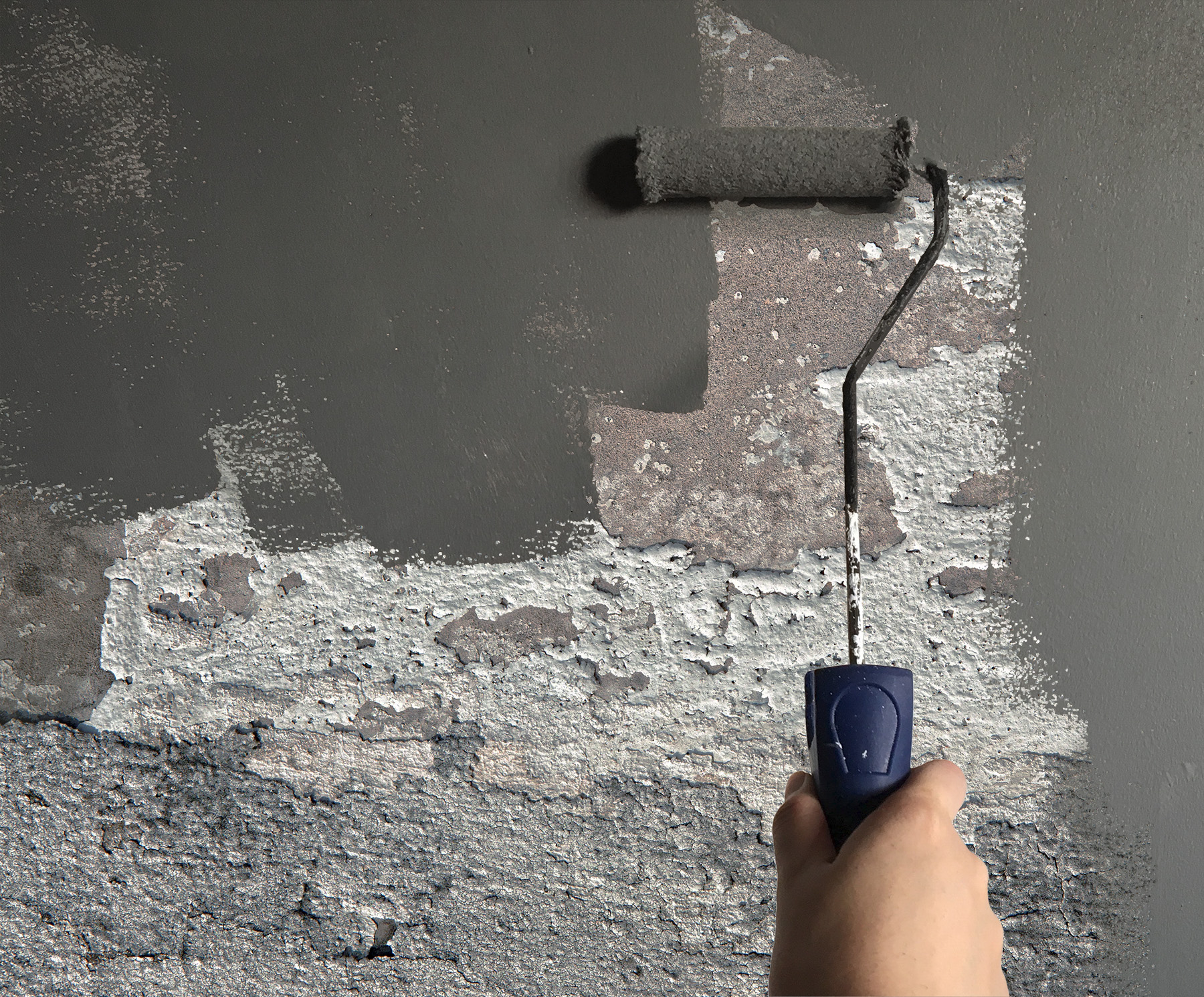
Tips For Painting Concrete Basement Walls
In this section, I’ll give you some tips and a brief rundown of my step-by-step process for painting concrete basement walls. For a full post on how to do it, visit my post on How To Paint Concrete Basement Walls.
Step 1: Inspect Your Basement Walls
Start by inspecting your walls for damage, leaks, moisture, and mold growth. If you find any issues, you need to deal with them before you start painting. Thoroughly clean mold away with warm water and vinegar solution. Fill in small cracks with caulk or liquid concrete crack filler, use hydraulic cement for medium size cracks, and repair large cracks with fresh concrete.
Trace the source and deal with any leaks or moisture you find. You do not want to paint concrete basement walls that have water issues.
If the walls are damp, dry them off before painting. The best way is using ventilation. Open windows and doors and use fans to blow fresh air over the walls until they dry out.
Step 2: Preparation
Move furniture and other items away from where you’ll be painting, put down tarps, and use tape and plastic sheeting to mask areas where you don’t want paint. If your basement isn’t well-ventilated, open some windows and doors or bring in a fan to create air circulation.
If the walls have old chipping or flaking paint, strip damaged areas off. Use a stiff wire brush and paint scraper to remove loose and damaged sections of paint. You don’t have to remove all the old paint, just damaged areas that are already chipping. Once you’re done removing paint chips, lightly sand the edges of the chipped paint so that it feathers into the wall.
Step 3: Clean The Concrete
Before painting or priming, I always clean the concrete surface. This helps the paint/primer adhere better to the surface. I use a clean cloth to lightly wash the wall with warm water. A pressure washer can help remove mold or mildew growth and efflorescence if the basement is unfinished and has a drain.
I use a commercial grease remover and a stiff bristle brush if I find any grease or oils stuck to the walls. Goo-Gone is a great product if something is gunked onto the walls.
Don’t use paper towels or towels that are fluffy, the rough texture of the concrete will tear them up and leave residue on the walls.
Step 4: Prime Or Seal The Walls
If you’re using concrete paint or primer before a top coat of paint, now’s the time to apply it. A masonry primer or sealer helps block out moisture and protects the paint from concrete’s alkalinity.
Keep in mind that some sealants and primers can have toxic fumes, so choose one that’s water-based instead of oil-based. Water-based paints are easier to work with, go on easier, and don’t smell nearly as bad.
However, no matter what type of primer, paint, or sealer you use, always apply paints with ventilation. Open windows and doors, and use a fan to promote good airflow.
- Apply a waterproof primer or sealer to the concrete walls with a thick nap roller
- A thicker roller is better because it applies paint into pores and cracks
- The rougher the surface of your walls, the thicker your roller should be
- Use a brush for especially deep pores and cracks, edges, corners, details work and areas the roller won’t fit
- Concrete primers and sealers can also be applied with a sprayer
- Allow each coat to dry before applying the next
The color of your primer should coincide with the color of your top coat. For lighter-colored paint, use a white primer, for darker shades, use a dark grey primer.
Step 5. Paint The Walls
Once your sealer or primer dries, or if you’re painting directly onto the concrete without a primer or sealer, use a high-quality eggshell paint. An eggshell sheen is enough to provide some additional scratch and stain resistance for the walls. Also, look for paint with a high pigment content and some UV protection to prevent fading.
- Apply the paint using a brush, roller, or sprayer in light coats
- Let the paint dry before painting the next coat
- Paint an entire wall in one pass rather than ins sections to avoid dry edges
- I recommend using acrylic paint
- The roller nap should match the texture of your concrete wall
- Use a thicker nap roller for highly textured walls and a short nap for smooth surfaces
- Choose a brush with tough bristles because the rough concrete surface will tear them up
- Don’t use a cheap brush or you’ll end up with lots of hairs stuck in your paint
Once you’re all done painting, remove your tape and masking, pick up the tarps, clean the room, and put back all your furniture. And make sure to clean all your brushes, tools, and equipment for the next paint project.
Summary: Best Paint For Concrete Basement Walls
The best paint for concrete basement walls is acrylic masonry paint. Concrete is a type of masonry that is very porous and prone to cracking as it expands and contracts. It absorbs water from the outside, which then transfers through the walls’ deep pores and into the basement. This is why many basements become damp with an odd musty smell. Concrete also expands and contracts when the temperature changes, which can cause cracking. Masonry paint is flexible, which means it can move without cracking, and it’s water resistant, which helps keep your basement dry and mold-free. Latex, epoxy, and elastomeric masonry paints are also great choices for concrete basement walls.
Another great quality of masonry paint is that it breathes. This is essential for painting basement walls because airflow helps keep the concrete dry.
Many basement walls allow moisture to seep in from the outside. This can eventually lead to mold and mildew growth from sweat forming on the walls. Because of this, you can’t use regular wall paints to coat the walls. Standard paints will peel, crack, flake, and chip off when the walls become damp. But masonry paint stays secure on the walls because it breathes.
Regular house paints aren’t designed for use in high-humidity environments. They only provide color but don’t function as a sealer. Basement walls need special waterproof paint that keeps moisture from penetrating through the walls and into the basement. As a result, mold and mildew growth, and that musty smell many basements have, can be prevented.
If you have any questions or comments about which paint is best for your concrete basement walls, email any time.

John Mazzuca | About | More Posts |
Custom Home Builder
John Mazzuca is a custom home designer and builder at Gambrick with over 25 years experience in the construction industry. John has designed, built and/or remodeled hundreds of homes, small buildings, and commercial projects. He writes about business, real estate, home building, and household electronics. His work has been featured in Fox Business, Better Homes & Garden, House Beautiful, and more.
